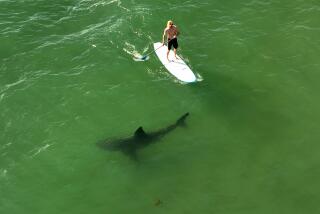Scientists Hope to Size Up the Health of the Ocean in a Heartbeat
- Share via
The question, posed by a group of high school teachers at USC’s Wrigley Institute Saturday, had the makings of the set-up for a bad joke. How do you monitor the heartbeat of a crab?
The answer, it turned out, was more than obvious: Carefully.
For the nine local high school teachers, the weekend conference on Catalina Island, which was sponsored by USC and the Global Heartbeat program, was a fun way to learn about the ins and outs of heart-rate monitors for the ocean-dwelling set. It also proved to be a powerful demonstration about how environmental factors can affect the health and well-being of crabs. Scientists believe that crabs’ heartbeats -- which can be detected through the animals’ shells -- are prime indicators of the ocean’s health, in part because they slow down when exposed to certain kinds of environmental toxins.
Monitoring the heartbeat of a crab requires that a small infrared sensor be skillfully super-glued to the center of the crab’s dorsal shell. It demands a sophisticated computer program to connect with the sensors, charting heart rate in a series of graphs and numbers. And it entails a bit of patience with animals that can be ornery at best.
“It’s hands-on, and it’s original,” said Peter Tuddenheim, one of the originators of Global Heartbeat, a nonprofit group based in Potomac Falls, Va. More than anything, he said, “it’s a catalyst for questions.”
Tuddenheim admitted that part of Global Heartbeat’s appeal is the “emotive thing.” People, he said, don’t realize that crabs have heartbeats -- or that they can exhibit the same sort of reactions that characterize humans.
Take Sebastian, a striped shore crab, or Pachygrapsus crassipes, native to Pacific waters stretching from Oregon to Baja California. Nicknamed by Liz Nelson, a science teacher at Hamilton High School in Los Angeles, after a singing decapod in Disney’s “The Little Mermaid,” Sebastian was caught Saturday morning by the teachers in the muddy waters off Catalina’s Two Harbors.
At first, Sebastian and the other crabs seemed mellow, even passive.
Once back at the lab, however, Sebastian moved fast. As soon as Judy Lemus, West Coast science specialist for Global Heartbeat and a member of USC’s Sea Grant program, took the 1 1/2-inch crab out of his seawater habitat and placed him in a small plastic shoebox, which she handed to Nelson, he started snapping pincers open and shut.
Nelson squirmed, and quickly placed a lid on the box. “What are you, a physics teacher?” asked Everett Yee, who teaches marine science at Mira Costa High School in Manhattan Beach. For this group of teachers, many of whom focus on biology and environmental science, it was the ultimate put-down.
“It’s just -- the animals we usually deal with are dead,” Nelson replied. “I wanted a more mellow crab.”
Soon, Sebastian was hooked up to an infrared sensor that had been adapted from technology originally developed to monitor the heart rates of premature babies. Over the next few hours, he and 11 of his fellow arthropods would run the equivalent of a crab gantlet, with heart-rate monitors attached. The teachers would subject them to temporary variations in salinity, temperature and water levels, all to test how crab heart rates react to changing conditions.
Sebastian also got to experience what Tuddenheim calls “crab aerobics” -- a sort of seismic pad that twisted and turned, mimicking ocean tides. His heart rate fluctuated between 45 and 114 beats per minute, depending on the activity.
In one experiment, Nelson and Kenny Sreshta, who also teaches science at Hamilton High, placed two crabs in boxes side by side and waited for normal heartbeats before they began cooling the water of one habitat.
Even before they had begun that, though, the teachers watched as one crab’s heart rate climbed from 35 to 147, and then jumped back downward, all in a matter of minutes.
Even the fluorescent lights in the lab could make a difference in the sensor readings, Tuddenheim told the teachers. “There are all kinds of environmental issues you need to think about.”
After the experiments, the sensors were removed and the crabs released back into the ocean.
Besides running their own experiments, the teachers were encouraged to integrate the heart-rate technology into their own curriculums. Each had different ideas about what would excite their students. One thought a comparison of human and crab heartbeats might be interesting. Another was considering teaching about ecological variables.
They are part of a pilot program being run by Global Heartbeat, which hopes for eventual participation of students worldwide.
Tuddenheim wants to create a global network of budding scientists who will help the group establish baseline heart rates for different types of crabs and then watch to see whether the rates change over time.
So far, the program is being used by students in Maryland and Virginia, and last summer, a group of middle school girls learned about the heart-rate monitors at the Wrigley Institute.
Craig Sipes, who teaches Integrated Science III at Washington Preparatory High School in South Los Angeles, had a more basic reason for wanting to participate in the program.
There is a huge disconnect, he said, between his students and anything that happens outside of their mostly inner-city neighborhoods. Many of them had seen the beach only on television, he added. Collecting crabs at a local beach and then caring for the animals inside the classroom -- the crabs keep the sensors on for a few hours -- would provide the students a different way to connect to their environment.
“One of the bigger reasons to do this project is to get them involved in beaches, and to experience nature that they don’t see in the city,” said Sipes. “I’m thinking that this could be a way of getting them to care about things outside of themselves.”






